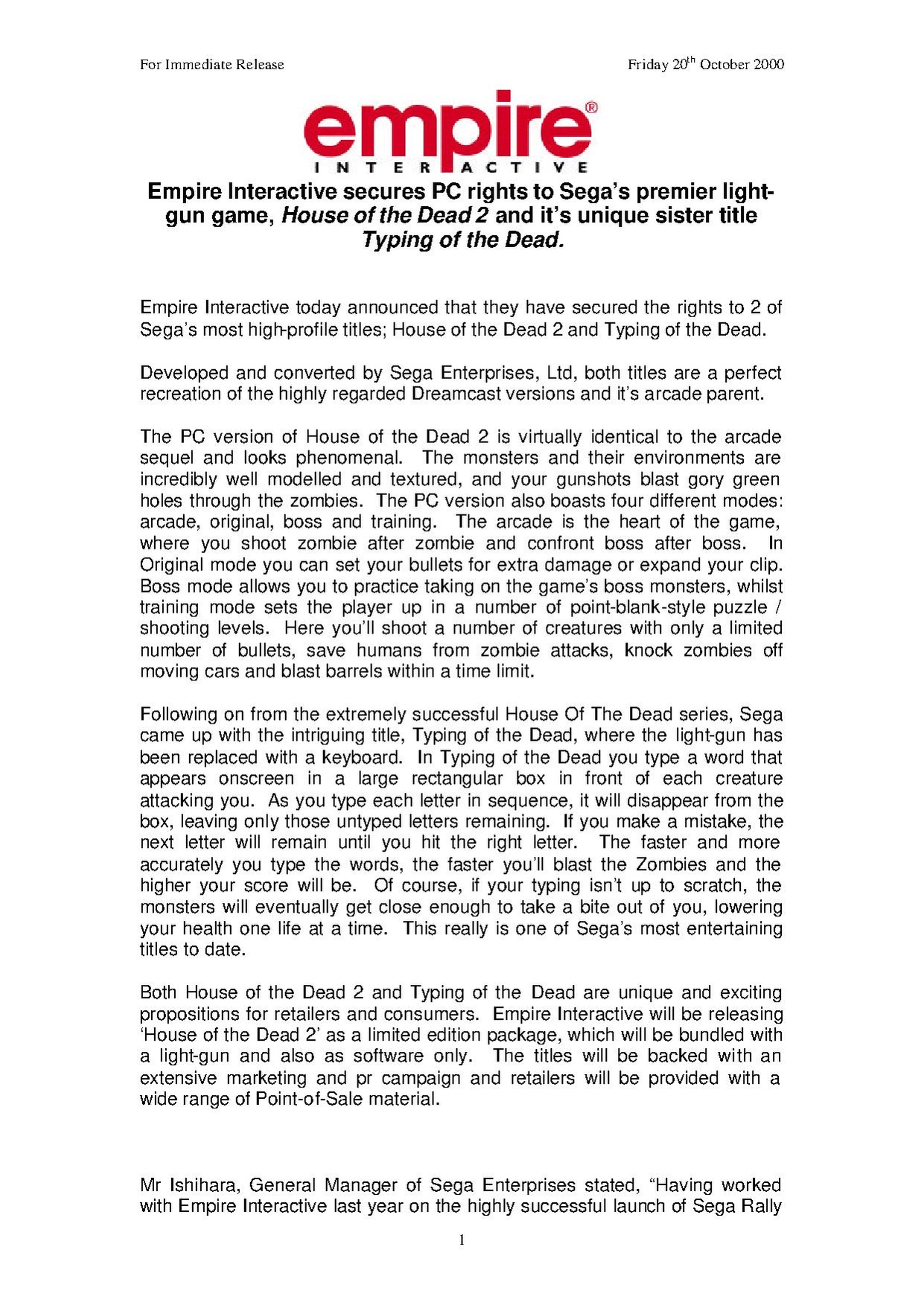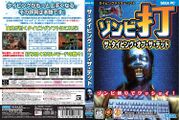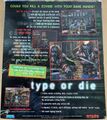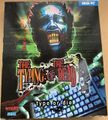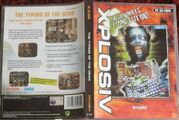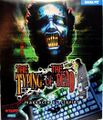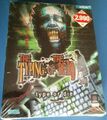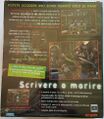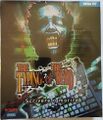Difference between revisions of "The Typing of the Dead"
From Sega Retro
| Line 9: | Line 9: | ||
| peripherals={{DC}} [[Dreamcast VGA Box]], [[Dreamcast Keyboard]], [[Visual Memory Unit]] | | peripherals={{DC}} [[Dreamcast VGA Box]], [[Dreamcast Keyboard]], [[Visual Memory Unit]] | ||
| players=1-2 | | players=1-2 | ||
| − | | genre= | + | | genre=Typing{{ref|https://web.archive.org/web/20130801045218/http://sega.jp/dc/000315/}}{{ref|https://web.archive.org/web/20011031094652/http://sega.jp/pc/tod/}} |
| releases={{releasesArcade | | releases={{releasesArcade | ||
| naomi_date_jp=2000-01{{magref|dmjp|2000-18|151}}{{fileref|Sega Arcade History JP EnterBrain Book-1.pdf|page=171}} | | naomi_date_jp=2000-01{{magref|dmjp|2000-18|151}}{{fileref|Sega Arcade History JP EnterBrain Book-1.pdf|page=171}} | ||
| Line 17: | Line 17: | ||
| dc_date_us=2001-01-23 | | dc_date_us=2001-01-23 | ||
| dc_code_us=51144 | | dc_code_us=51144 | ||
| + | | dc_rating_us=m | ||
| dc_rrp_us=39.99{{magref|odmus|12|81}} | | dc_rrp_us=39.99{{magref|odmus|12|81}} | ||
| − | | dc_date_jp=2000-03-30 | + | | dc_date_jp=2000-03-30{{ref|https://web.archive.org/web/20130801045218/http://sega.jp/dc/000315/}} |
| dc_code_jp=HDR-0067 | | dc_code_jp=HDR-0067 | ||
| − | | dc_rrp_jp=4, | + | | dc_rrp_jp=4,800e{{ref|https://web.archive.org/web/20130801045218/http://sega.jp/dc/000315/}} |
| − | | dc_date_jp_1=2000-03-30 | + | | dc_rating_jp=v |
| + | | dc_date_jp_1=2000-03-30{{ref|https://web.archive.org/web/20130801045218/http://sega.jp/dc/000315/}} | ||
| dc_code_jp_1=HDR-0085 | | dc_code_jp_1=HDR-0085 | ||
| − | | dc_rrp_jp_1=8, | + | | dc_rrp_jp_1=8,800e{{ref|https://web.archive.org/web/20130801045218/http://sega.jp/dc/000315/}} |
| − | | dc_type_jp_1=Keyboard | + | | dc_rating_jp_1=v |
| + | | dc_type_jp_1=Keyboard Doukon-ban | ||
}} | }} | ||
{{releasesPC | {{releasesPC | ||
| Line 69: | Line 72: | ||
| pc_rating_it_xp=15 | | pc_rating_it_xp=15 | ||
}} | }} | ||
| − | |||
| − | |||
| − | |||
| − | |||
| − | |||
}} | }} | ||
'''''{{PAGENAME}}''''' (ザ・タイピング・オブ・ザ・デッド) is a [[Sega NAOMI]] game released in 1999 based on ''[[The House of the Dead 2]]''. While the latter is a standard light gun shooter, ''Typing'' replaces the gun with the keyboard. | '''''{{PAGENAME}}''''' (ザ・タイピング・オブ・ザ・デッド) is a [[Sega NAOMI]] game released in 1999 based on ''[[The House of the Dead 2]]''. While the latter is a standard light gun shooter, ''Typing'' replaces the gun with the keyboard. | ||
| Line 246: | Line 244: | ||
}} | }} | ||
{{Scanbox | {{Scanbox | ||
| − | |||
| − | |||
| − | |||
| − | |||
| − | |||
| − | |||
| − | |||
| − | |||
| console=Dreamcast | | console=Dreamcast | ||
| region=JP | | region=JP | ||
| Line 264: | Line 254: | ||
}}{{Scanbox | }}{{Scanbox | ||
| console=Dreamcast | | console=Dreamcast | ||
| − | | region=JP ( | + | | region=JP (Keyboard Doukon-ban) |
| front=TTotD DC JP Box Front WithKeyboard.jpg | | front=TTotD DC JP Box Front WithKeyboard.jpg | ||
| + | }}{{Scanbox | ||
| + | | console=Dreamcast | ||
| + | | region=US | ||
| + | | front=TTotD DC US Box Front.jpg | ||
| + | | back=TTotD DC US Box Back.jpg | ||
| + | | square=yes | ||
| + | | disc=TTotD DC US Disc.jpg | ||
| + | | inlay=THOTDDCUSInlay.jpg | ||
}} | }} | ||
Revision as of 15:50, 27 February 2020
| The Typing of the Dead | |||||||||||||||||||||||||||||||||||||||||||||||||||||||||||||||||||||||||||||||||||||||||
|---|---|---|---|---|---|---|---|---|---|---|---|---|---|---|---|---|---|---|---|---|---|---|---|---|---|---|---|---|---|---|---|---|---|---|---|---|---|---|---|---|---|---|---|---|---|---|---|---|---|---|---|---|---|---|---|---|---|---|---|---|---|---|---|---|---|---|---|---|---|---|---|---|---|---|---|---|---|---|---|---|---|---|---|---|---|---|---|---|---|
| System(s): Sega NAOMI, Sega Dreamcast, Windows PC | |||||||||||||||||||||||||||||||||||||||||||||||||||||||||||||||||||||||||||||||||||||||||
| Publisher: Sega Empire Interactive | |||||||||||||||||||||||||||||||||||||||||||||||||||||||||||||||||||||||||||||||||||||||||
| Developer: Sega Software R&D Dept. 6[1] H.I.C. | |||||||||||||||||||||||||||||||||||||||||||||||||||||||||||||||||||||||||||||||||||||||||
| Peripherals supported: Dreamcast VGA Box, Dreamcast Keyboard, Visual Memory Unit | |||||||||||||||||||||||||||||||||||||||||||||||||||||||||||||||||||||||||||||||||||||||||
| Genre: Typing[2][3] | |||||||||||||||||||||||||||||||||||||||||||||||||||||||||||||||||||||||||||||||||||||||||
| Number of players: 1-2 | |||||||||||||||||||||||||||||||||||||||||||||||||||||||||||||||||||||||||||||||||||||||||
|
The Typing of the Dead (ザ・タイピング・オブ・ザ・デッド) is a Sega NAOMI game released in 1999 based on The House of the Dead 2. While the latter is a standard light gun shooter, Typing replaces the gun with the keyboard.
While the game is an educational game, as it requires players to enhance their typing skills to be successful, it has been praised by critics primarily for its comedic content. It was later brought to the Sega Dreamcast and Windows PCs.
The success of this game, particularly in Japan, led to many variations of The Typing of the Dead. This article covers the original NAOMI arcade version and its ports to the Sega Dreamcast and Windows PCs. It also includes the Japanese release of The Typing of the Dead US Edition (ザ・タイピング・オブ・ザ・デッド USエディション), as this is the Japanese release of the US version of the game. For the Japanese-only variants, see The Typing of the Dead 2003, The Typing of the Dead 2004 and The Typing of the Dead Syoukai.
Contents
Plot
The plot of the game follows that of The House of the Dead 2 almost completely. The story begins on February 26, 2000, where another zombie outbreak has occurred and several AMS agents have been dispatched to investigate. The player can control two characters, James and Gary, who are first sent to find the original game's "G" before being tasked with restoring order. Responsibility for the outbreaks is soon traced to "Goldman," a banking tycoon and scientist who is attempting to end human control of the earth. Much of the game revolves around destroying Goldman's creations, concluding with the final boss of "the Emperor." There are three possible humorous ending sequences, dependent on how the final questions asked to defeat the Emperor were answered.
Gameplay
The Typing of the Dead has been described variously as a remake or mod of the original House of the Dead 2. Like the original, Typing of the Dead is styled as a first-person rail shooter game, but substitutes shooting zombies and other enemies with typing out words or phrases to kill them. When enemies appear, they are accompanied by a box showing a word, sentence or phrase which must be typed to neutralize the enemy. The length, and complexity, of the phrases increase during the game's progression. Other features retained include the challenges of saving survivors, which will alter the path the player character will take to his final destination, and the secrets/bonus items hidden throughout the game.
All levels contain specific challenge areas, where the player is required to kill a certain number of zombies in limited time, and are ended with a boss battle using some sort of alteration of usual gameplay (e.g. a long phrase, typing the correct answer to a question etc.) The console ports have two modes, "Original" and "Arcade," for the main storyline, as well as "Tutorial," "Drill," and "Boss" modes for additional typing training. Other changes are mostly superficial, including replacing the weapons wielded by zombies with harmless items and equipping the AMS agents with keyboards attached to backpack Dreamcasts with oversized batteries.
History
Releases
| This article needs cleanup. This article needs to be edited to conform to a higher standard of article quality. After the article has been cleaned up, you may remove this message. For help, see the How to Edit a Page article. |
The Typing of the Dead was first released for arcades in Japan in 1999 with a special arcade cabinet equipped with dual QWERTY keyboards. The game was WOW Entertainment and one of the second developments by Smilebit, a developer team from Sega which had recently spun off as a new company.
The first home console release was made for the Japanese Dreamcast market on March 30, 2000. The North American release was made the following year in January. A PC port was produced by Empire Interactive, and released in September 2001.
Another port of the game was for the PlayStation 2, titled The Typing of the Dead: Zombie Panic. This version was released exclusively in Japan in late December 2004, and was packaged with a USB keyboard. The game was mostly unchanged, disappointing observers hoping for an update of the graphics, although the Dreamcast backpacks were replaced with PS2 backpacks and new "minigames" were incorporated into the main story.
Also, in Japan the PC port had its updates as separate games. It had a total of 6 releases:
- The Typing of the Dead JP (Romanji/Hiragana Alphabet / December 7, 2000)
- The Typing of the Dead US (English Alphabet / September 20, 2001)
- The Typing of the Dead 2003 (Romanji/Hiragana Alphabet / December 5, 2002)
- The Typing of the Dead 2004 (Romanji/Hiragana Alphabet / December 4, 2003)
- The Typing of the Dead JP Ver 2 (Romanji/Hiragana/English Alphabet / September 22, 2005)
- The Typing of the Dead Syoukai (Romanji/Hiragana/English Alphabet / July 12, 2006)
The demos of these releases can be found on the official Typing of the Dead Japanese website.
A sequel game, The Typing of the Dead 2, was released in 2007. This version was a revision of The House of the Dead 3, and has only been released in Japan as of 2008.
Production credits
Dreamcast version
- Producers: 新井 瞬, 中川 力也, 川越 隆幸
- Planners: 島村 誠人, 市川 宏, 川瀬 覚
- Designers: 田中 智治, 高梨 真, 志村 圭介
- Sound Designers: 河内 哲也, 冨田 晴義, 剱田 奈々絵
- Programmers: 上田 展生, 中村 晃章, 廣中 芳憲, 高橋 直人, 杉田 雅宏
- Publicity: 荒木 美佳, 久田 祐通
- Special thanks to: 佐藤 義尚, 大戸 孝二, THE HOUSE OF THE DEAD2 チーム, 村橋 貴史, 玉泉 俊輔, 高瀬 克也
- Director: 椎野 真光
- Presented by: Sega™
- ©Sega Enterprises, Ltd., 2000
- Producers: Rikiya Nakagawa, Shun Arai, Takayuki Kawagoe
- Director: Masamitsu Shiino
- Planners: Masato Shimamura, Wataru Taguchi
- Designers: Makoto Takanashi, Tomoharu Tanaka
- Programmers: Isao Watanabe, Naoto Takahashi, Tensei Ueda, Teruaki Nakamura, Yoshinori Hironaka
- Sound Designer: Tetsuya Kawauchi
- Word Editors: Osamu Shibamiya, Satoko Arima, Luke Valentine, Yoko Sasaki
- Special Thanks: Jin Shimazaki, Koji Ooto, Yoshinao Satou
- Created By: WOW Entertainment, Smilebit (Co-Developer)
- Presented By: Sega
- Product Development:
- Localization Producer: Jason Kuo
- Localization Manager: Osamu Shibamiya
- VP of Localization: Jin Shimazaki
- Lead Tester: Steve Peck
- Assistant Lead: Tor Unsworth
- Marketing:
- Product Manager: Stacey Kerr
- Associate Product Managers: Cord Smith, Dennis Lee
- Sega of Japan Manual Product Staff:
- Writer/Editor/Translator: Luke Valentine
- Writer: Eiichi Ogawa
- DTP Operator: Makoto Nishino
- Designer: Naohiko Iida
- Supervisor: Kaoru Ichigozaki
- Special Thanks: Chris Lucich, Mari Schaal, Simon McIlroy, John Golden, Angela Santos, John Amirkhan, Sandy Castagnola
PC version
- Producers: Shun Arai, Rikiya Nakagawa, Takayuki Kawagoe, Masato Ozutsumi
- Director: Masamitsu Shiino
- Planners: Wataru Taguchi, Youichirou Inoue
- Designer: Tomoharu Tanaka
- Programmers: Tensei Ueda, Ryou Matsunuma, Kouji Nakamura, Teruaki Nakamura, Kunihide Izawa, Eiji Horita, Jun Fukushima
- Sound Designers: Hirofumi Murasaki, Keiichi Sugiyama
- Word Editors: Luke Valentine, Osamu Shibamiya, Satoko Arima, Yoko Sasaki
- Special Thanks: Jin Shimazaki, Ken Seki, Luke Valentine, Nobuhiko Ishihara, Katsuji Doujun, Yasushi Nakajima, Ryousuke Kaji, Gou Tokunaga, Masaru Igarashi, Toshirou Nakayama
- Created By: WOW Entertainment, Smilebit (Co-Developer)
- Presented By: Sega
- Design Coordinator: Benedict Wilkins
- Product Manager: Stephen Wickes
- Art: Phil Goldfinch, Paul Flewitt, Stephen Brennan
- Lead Testers: Florence Kum, Lee Clarke
- Testers: Simon Lewis, Nmlotey Nartey, Mark Klocek, Edward Albert Wilson, Christopher Giggins
- Special Thanks: Tristram, Danny, Ian, Justin, James, Liz, Jimmy
- Producer: Brian M. McGinn
- VP of Business Development: Jamie Leece
- VP of Publishing: Chris Mate
- Graphic Artist: Christine Lagna
- QA Supervisor: Frank Kirchner
- Lead Tester: Stephen Thomas
- Quality Assurance: Lisa Nawrot, Kai Ma, Josh Rose, Joe Covello, Stacey Sharpe, Joshua Noll, Scott Vail
Magazine articles
- Main article: The Typing of the Dead/Magazine articles.
Promotional material
also published in:
- Dreamcast Magazine (JP) #2000-15: "2000-15 (2000-04-28)" (2000-04-14)[10]
Artwork
Physical scans
NAOMI version
Dreamcast version
| Sega Retro Average | ||||||||||||||||||||||||||||||||||||||||||||||||||||||||||||||||||||||||||||||||||||
|---|---|---|---|---|---|---|---|---|---|---|---|---|---|---|---|---|---|---|---|---|---|---|---|---|---|---|---|---|---|---|---|---|---|---|---|---|---|---|---|---|---|---|---|---|---|---|---|---|---|---|---|---|---|---|---|---|---|---|---|---|---|---|---|---|---|---|---|---|---|---|---|---|---|---|---|---|---|---|---|---|---|---|---|---|
|
| 78 | |
|---|---|
| Based on 16 reviews | |
PC version
| PC, UK (Xplosiv) |
|---|
| PC, IT (Xplosiv) |
|---|
| PC, KR |
|---|
|
Technical information
ROM dump status
| System | Hash | Size | Build Date | Source | Comments |
|---|
External links
- Sega of Japan catalogue pages (Japanese): Dreamcast, PC, PC (US Edition), PC (DVD Value), PC (10th Anniversary)
References
- ↑ 1.0 1.1 Sega Arcade History, Enterbrain, page 171
- ↑ 2.0 2.1 2.2 2.3 2.4 http://sega.jp/dc/000315/ (Wayback Machine: 2013-08-01 04:52)
- ↑ 3.0 3.1 http://sega.jp/pc/tod/ (Wayback Machine: 2001-10-31 09:46)
- ↑ Dreamcast Magazine, "2000-18 (2000-05-26)" (JP; 2000-05-12), page 151
- ↑ 5.0 5.1 Official Dreamcast Magazine, "March 2001" (US; 2001-01-28), page 81
- ↑ 6.0 6.1 http://sega.jp/search/result.php?page=7&pf=11 (Wayback Machine: 2017-03-04 10:30)
- ↑ http://sega.jp/pc/todus/ (Wayback Machine: 2001-12-01 23:16)
- ↑ 8.0 8.1 http://sega.jp/pc/todvalue/ (Wayback Machine: 2005-11-16 17:49)
- ↑ 9.0 9.1 http://sega.jp/pc/tod10th (Wayback Machine: 2010-03-26 14:16)
- ↑ Dreamcast Magazine, "2000-15 (2000-04-28)" (JP; 2000-04-14), page 2
- ↑ 11.0 11.1 Consoles +, "Juin 2000" (FR; 2000-0x-xx), page 129
- ↑ 12.0 12.1 Dreamcast Magazine, "2000-12 (2000-04-07)" (JP; 2000-03-24), page 27
- ↑ 13.0 13.1 Dorimaga, "2002-18 (2002-10-11)" (JP; 2002-09-27), page 32
- ↑ Official Dreamcast Magazine, "March 2001" (US; 2001-01-28), page 77 (81)
- ↑ Dreamcast Magazine, "No. 20" (UK; 2001-03-22), page 68
- ↑ Electronic Gaming Monthly, "March 2001" (US; 2001-02-06), page 110
- ↑ Entsiklopediya igr dlya Dreamcast, "Izdaniye chetvertoye, dopolnennoye" (RU; 2002-xx-xx), page 284
- ↑ Famitsu, "2000-04-07" (JP; 2000-03-24), page 31
- ↑ GamePro, "March 2001" (US; 2001-0x-xx), page 93
- ↑ Game Informer, "February 2001" (US; 2001-0x-xx), page 99
- ↑ Gamers' Republic, "January 2001" (US; 2000-12-20), page 83
- ↑ MAN!AC, "06/2000" (DE; 2000-05-03), page 50
- ↑ Neo Plus, "Marzec 2001" (PL; 2001-xx-xx), page 56
- ↑ PSX Extreme, "05/2001" (PL; 2001-0x-xx), page 52
- ↑ Strana Igr, "Sentyabr 2000 2/2" (RU; 2000-xx-xx), page 21
- ↑ Video Games, "06/2000" (DE; 2000-05-04), page 124
- Dreamcast Keyboard-compatible games
- Dreamcast VGA Box-compatible games
- Visual Memory Unit-compatible games
- 1-2 player games
- All arcade games
- NAOMI games
- 2000 NAOMI games
- All 2000 games
- JP Dreamcast games
- All JP games
- US Dreamcast games
- All US games
- Dreamcast games
- 2000 Dreamcast games
- Dreamcast table games
- All table games
- JP Windows PC games
- US Windows PC games
- DE Windows PC games
- All DE games
- ES Windows PC games
- All ES games
- FR Windows PC games
- All FR games
- UK Windows PC games
- All UK games
- IT Windows PC games
- All IT games
- KR Windows PC games
- All KR games
- PC games
- 2000 PC games
- PC table games
- Windows PC games
- All games
- Cleanup
- Credits without reference
- Credits without source
- GalleryPrintAd file defined
- Old-style rating (consolesplus)
- Old-style rating (dmjp)
- Old-style rating (dmjp r)
- Old-style rating (famitsu)
- Rating without PDF source
- Old-style rating (odmus)
- Update ratings template
- 5 old ratings
- No ROM dumps
- Missing ROM dumps
- Old technical information
- The House of the Dead (franchise)




